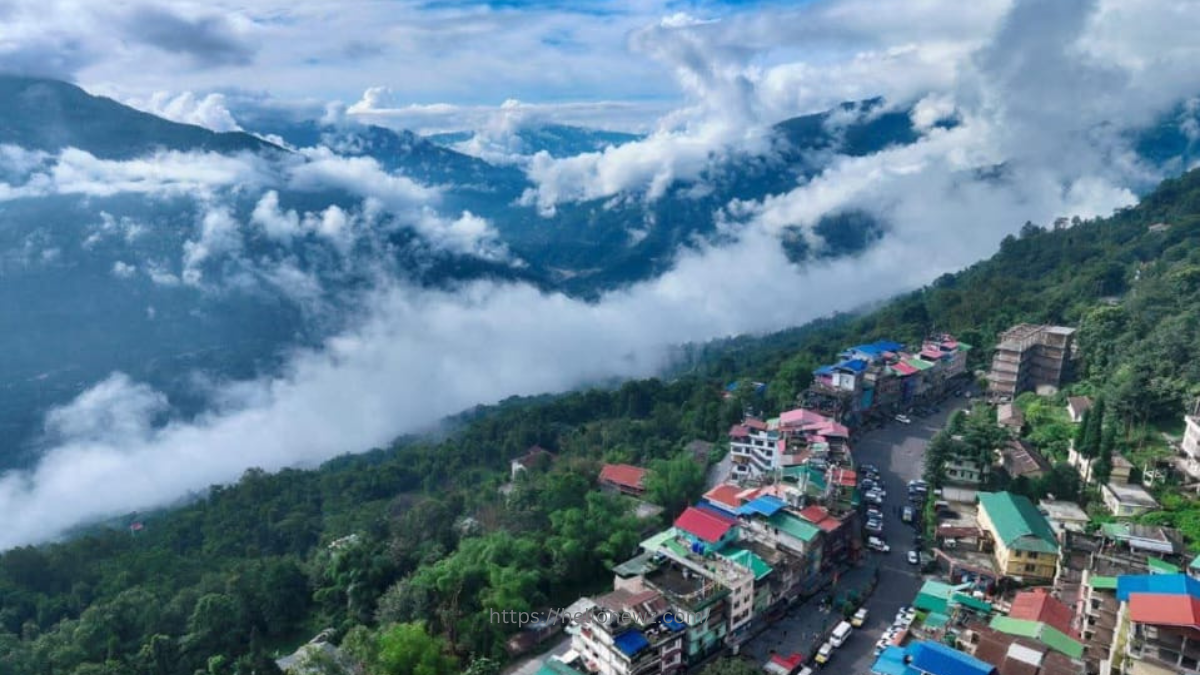The Government of Sikkim is showcasing two of its emerging tourism destinations — Yangang in Namchi district and Soreng in West Sikkim — at the Travel and Tourism Fair (TTF) Kolkata 2025, which commenced on 10 July 2025 at the Biswa Bangla Mela Prangan, opposite Science City.
The three-day travel trade event, one of India’s largest tourism platforms, is being attended by delegates from various Indian states and international representatives. Sikkim’s pavilion, themed around “Sikkim reveals it’s soul”, is drawing attention for its focus on eco-tourism, spiritual tourism, and community-based homestay experiences.
Officials from the Department of Tourism and the Department of Information and Public Relations (IPR), Government of Sikkim, said that the State’s participation at TTF Kolkata 2025 is part of a wider push to diversify tourism beyond the capital Gangtok and popular locations like Tsomgo Lake and North Sikkim.
“Yangang and Soreng offer not just nature and peace but also sustainability and community engagement. These are not mere tourist spots — they are part of a conscious tourism policy aimed at environmental balance and economic inclusion,” said a senior official from the Tourism Department.
Yangang’s recent strides
Yangang has been receiving attention after hosting the International Youth Conclave for Tourism Development in April this year, which coincided with the celebration of Sikkim’s 50th year of statehood. The conclave saw participation from over 170 international and national delegates, including representatives from Bhutan, Nepal, Thailand, and Iran.
The event was marked by cultural exhibitions, rural tourism showcases, panel discussions, and adventure tourism activities, including the highlight — the Dhapper–Bhaleydhunga ropeway, inaugurated earlier this year. Stretching over 3.5 kilometres, the ropeway is India’s longest single-span passenger lift system and considered one of the top five toughest ropway in the world which provides panoramic views of the Eastern Himalayas.
In addition to the ropeway, Yangang is also preparing for the launch of a 104 -metre glass skywalk at Bhaleydhunga, expected to become a major tourist draw in eastern India. Local self-help groups, youth entrepreneurs, and cultural performers have also been integrated into the tourism ecosystem through skill training and financial support.
Soreng’s silent rise
Meanwhile, Soreng, designated as a district headquarters in 2021, is slowly emerging as a model for village and organic tourism. With its forested landscapes, remote waterfalls, and heritage homestays, Soreng is increasingly favoured by domestic travellers seeking authentic, offbeat experiences.
Over 100 homestays are now operational in the region, most run by local families. These offer immersive packages such as traditional cooking, cardamom farm visits, forest bathing, and local folklore evenings. Youth in the area have been trained under government schemes in eco-guiding, sustainable hospitality, and digital marketing.
Vindraban Dham and Barsey Sanctuary
Located in the serene village of Dodak in West Sikkim, Vindraban Dham is an emerging spiritual site that adds religious depth to Soreng’s growing tourism circuit. Nestled amidst lush hills and dense forests, the temple complex is dedicated to Lord Krishna and Radha, and features beautifully landscaped gardens, meditation areas, and cultural artwork reflecting Vaishnav traditions. Just about 5 kilometres from Soreng and roughly 50 kilometres from the popular Char Dham complex in Namchi, Vindraban Dham is fast becoming a peaceful retreat for pilgrims and spiritual travellers seeking less-crowded alternatives.
In contrast to its spiritual calm, Barsey Rhododendron Sanctuary, located around 38 kilometres from Soreng via Sombaria, offers vibrant natural experiences. Known for its stunning high-altitude Rhododendron blooms from March to May, the sanctuary is a trekker’s paradise, with panoramic views of the Singalila Range and glimpses of exotic Himalayan flora and fauna. Together, Vindraban Dham and Barsey Sanctuary present Soreng as a destination where spiritual reflection and nature exploration coexist, making it ideal for travellers seeking both inner peace and scenic adventure.
Tourism officials stated that a structured village trail circuit, connecting Soreng to nearby sites like Chakung, Zoom, and Jorethang, is in development and is expected to boost both footfall and livelihood opportunities in the western region of the State.
TTF Kolkata 2025 as a growth catalyst
Sikkim’s association with TTF dates back over a decade, but in the last two years, the collaboration has deepened. TTF was one of the key promotional partners of the International Tourism Festival held in Yangang earlier this year. The fair helped facilitate tourism partnerships, B2B meetings, and national media coverage for the festival.
At TTF Kolkata 2025, Sikkim unveiled Yangang and Soreng as its next key tourism destinations, supported by the STDA, YTDC, and the Sikkim Inspires initiative. The launch featured brand films highlighting Yangang’s ropeway and upcoming skywalk, and Soreng’s potential for rural and adventure tourism. The event was attended by senior officials and MLAs including Smt. Rajkumari Thapa and Mr. Aditya Golay, who emphasised the need for immersive, community-based travel experiences. A panel discussion led by strategist Robin Basnet focused on branding and sustainable tourism. The showcase reaffirmed Sikkim’s commitment to decentralised tourism under the leadership of Chief Minister P.S. Tamang.






Speaking at the inauguration, the Chief Executive Officer of Fairfest Media, which organises TTF, noted, “Destinations like Yangang and Soreng represent the future of tourism — rooted in nature, mindful of sustainability, and powered by communities. We are proud to support Sikkim in taking these models to a wider audience.”
Economic and environmental implications
Tourism contributes nearly 10% of Sikkim’s Gross State Domestic Product (GSDP). According to officials, more than 80% of tourism income historically came from Gangtok, Nathula, and North Sikkim. However, environmental concerns and seasonal saturation have prompted the Government to reorient its strategy towards decentralisation.This approach, supported by events like TTF, includes developing village tourism infrastructure, providing subsidies for rural homestays, promoting organic farm stays, and integrating digital tools to support small operators.
An internal report by the Department of Tourism indicates that post-pandemic travel trends have favoured smaller, less-crowded destinations. “Yangang and Soreng’s success lies in their ability to remain peaceful yet accessible,” said an official involved in destination development. Sikkim’s tourism model — based on harmony with nature, community participation, and quality over quantity — could serve as a replicable blueprint for other Himalayan states.
As the TTF Kolkata 2025 unfolds, Sikkim’s new destinations are quietly but surely leaving a strong impression — not through commercial appeal, but through their authentic charm, resilience, and the promise of mindful travel.

